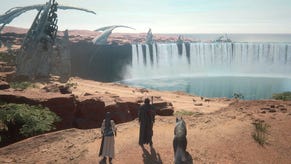Planet of Lana review - pace, poise and something more
Music of the spheres.
Sometimes it's interesting to put genre aside and think in terms of traditions. When it comes to genre, Planet of Lana is very easy to pinpoint: it's a 2D side scrolling puzzle platformer, more specifically one that focuses on stealth and cinematic storytelling. Traditions, though? That makes it much more intriguing.
The genre stuff alone is enough is to slot this in alongside games like Inside and Somerville - games with which it also shares an apocalyptic focus. the world is being over-run by horrors! Escape if you can! All good, but traditions can be surprising, and as I played Planet of Lana I found myself thinking a little bit about the idea of masterpieces. Not masterpieces in the modern usage of the word perhaps, but in the old sense - I may have this wrong but let's go with it for now - of the piece of work someone makes to show to the world that they are very good at something.
This is the masterpiece in the sense of making something self-consciously excellent. Making something, perhaps, where the creation of excellence is the central impulse, winning out over specific mechanics to be explored or a story that simply has to be told. In this way, the 2D cinematic platformer is perfect. Just as all of, say, Wedgwood's crowd knew what to expect from a bowl, so they could then judge that the Wedgwood bowl was just that little bit more refined in every way, modern audiences are familiar with 2D cinematic platformers. Limbo! Inside! All that jazz. We're so familiar with what they do and how they work that the eyes have a chance to shift focus a bit, and notice those little marks of cleverness and lightly-applied skill - sunshine playing on grass, grass shifting in the breeze, breeze stirring the soundtrack and beckoning you forward from one ideally conceived encounter to the next.
All of which is to say that nothing in Planet of Lana is really a surprise, but I'm not sure it's meant to be a surprise. It's meant to be elegantly done, and smartly detailed, and free of frustrations. And it is. And over time I think it became something more too.
The game starts off in a delightful bucolic community where people live off the land and wear smocks and build houses on stilts out of wood. Everything is artful chunks of rock, little rivers, and backdrops that scroll and suggest that this paradise goes on as far as we can see. Sadly, invaders are on the way, black metallic ships with cages for capturing people, huge tankers on legs that are presumably here to drink all that water and process all that wood, smaller units that rove around at the human level killing anyone they see. And black goop too - part of the invasion? Something different? Something useful? Let's see.
Escaping these alien threats means running left to right and navigating a series of puzzles, most of which revolve around stealth, as you sneak past those human-sized robot killing machines. Combat is absolutely not an option, which is an excellent choice for the game since it sharpens the design beautifully. Instead this is a series of challenges focusing on avoidance and manipulation, mixed in with traversal and some gently evolving skills.
At its simplest, there are patches of long grass to duck into and rock channels to sneak under as you learn enemy patrols - generally limited to a single screen or so - and look for openings. Things get more complex when you throw in some basic jumping and climbing challenges, and considerably more complex when you fall in with an adorable little creature, a sort of blob of ink inspired by both cats and dogs.



But not too inspired by cats, obv, since you tell this creature to do things and they obey you. You can direct them to ledges that you cannot reach in order to send down ropes for you, and you can send them into burrows to pop up somewhere else and lure robots away. Directing this creature is as simple as squeezing a trigger and aiming, and as events unfold you find more and more uses for them. They can weigh down pressure plates, nip through cables, and eventually control certain other parts of the ecosystem.
Crucially, though, at times they will need your help in return. You can tell them when to stay put and when to follow, but if you're separated by water, you're going to need to help them across. In this way, it's beautifully judged. This critter is useful, but it's also expressive and delicate and needs your care and assistance too. It fits perfectly into the world of simple one-by-one puzzles the game throws at you.
Planet of Lana has poise and pace. Its environments slowly change as you progress, moving from dreamy grasslands to murky woods, deserts, and some really strange spaces beyond. It knows when to give you a bit of a complex multi-part challenge - avoid enemies, trap them in a certain part of the level, make the environment safe before climbing it - and when to throw in some simple traversal your way so you can catch a breath. It sends you below ground, but never for so long that it becomes claustrophobic. It tells a steadily unfolding story, but so lightly that you can ignore it if you want to. Challenges scale by building on the things you've learned - you can swing on ropes, but what if they're sparking electrical cables now? - and there's something of the old elegant variation business to the way that Planet of Lana restlessly shuffles basic elements, never giving you quite the same challenge twice.


It's a game that disappears in pleasant little sips, in other words. Nothing is introduced that is not easy to understand, so that you can get to the fun of puzzling how to use it quickly. Nothing is arduous to use - your AI companion is both beautifully behaved and responds to very clear controls, as does all the machinery you get to interact with in the later acts. There are brainteasers here, but no frustrations. And as your abilities grow, you get a wider range of things to think about in each puzzle without it ever becoming overwhelming.
On top of this it's very stylish, with those pastel hand-painted grasses and fairytale trees giving way to different lands all of which balance beauty and readability. Great rocks in Planet of Lana! Great goop monsters with shining eyes. In one sequence I ran across a beach beneath and between the metal legs of giant striding robots - something I won't forget. In another I spent two minutes being spooked by a spider creature that turned out to be the perfectly angled leaves of a bush, designed just to spook me into thinking about spiders.
For a while, I was undecided about whether Planet of Lana ultimately wants to move people. I couldn't help but respond to the critter I travelled with, and the story goes through all the expected beats to make that relationship feel important. More than anything, though, I got the sense that Planet of Lana was in a sort of conversation with all the games that it is like. Look at how elegantly I can do this, it seemed to say, how subtly I can teach you this mechanic, and set up this story beat. Look at how nicely I can nest one puzzle in another and use the second to change the pace of the story for a section.

Yes, all of that. For sure, as I played, I never once forgot that I was playing a very skillfully crafted videogame - a masterpiece of the original meaning. But also: that scamper between the huge legs of stalking monsters. A cave where I encountered an ancient puzzle that was also - whisper it - a kind of musical instrument! A grotto where a beast loomed in the murk ahead, eyes glowing. In moments like this, sheer craft becomes something else, I think. It becomes a memory that will stay with me. The sense of having been in a special place that will pop up years from now when I least expect it.




